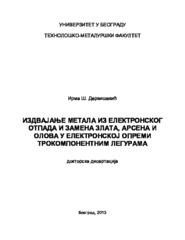Приказ основних података о дисертацији
Издвајање метала из електронског отпада и замена злата, арсена и олова у електронској опреми трокомпонентним легурама
Recovery of metals from electronic waste and substitution of gold, arsenic and lead in electronic appliances with теrnary alloys.
| dc.contributor.advisor | Ristić, Mirjana | |
| dc.contributor.other | Kamberović, Željko | |
| dc.contributor.other | Minić, Duško | |
| dc.creator | Dervišević, Irma | |
| dc.date.accessioned | 2016-08-27T16:05:39Z | |
| dc.date.available | 2016-08-27T16:05:39Z | |
| dc.date.available | 2020-07-03T09:24:21Z | |
| dc.date.issued | 2013-11-28 | |
| dc.identifier.uri | https://nardus.mpn.gov.rs/handle/123456789/6372 | |
| dc.identifier.uri | http://eteze.bg.ac.rs/application/showtheses?thesesId=3710 | |
| dc.identifier.uri | https://fedorabg.bg.ac.rs/fedora/get/o:12526/bdef:Content/download | |
| dc.identifier.uri | http://vbs.rs/scripts/cobiss?command=DISPLAY&base=70036&RID=44866063 | |
| dc.description.abstract | Широк спектар застарелих електричних и електронских уређаја чини отпад од електричне и електронске опреме (EE–отпад). Он глобално рас те по стопи од 3 до 5 % годишње, што га чини најбрже растућим отпадом на планети. Према проценама Уједињених нација, у свету се годишње произведе 20 до 50 милиона тона EE–отпада, односно сваког сата 4000 тона. Проблем није само у количини већ и у токсичности састојака овог отпада, који представља велику опасност по природу и здравље људи. Један од приоритета у области управљања овом врстом отпада је управо заштита животне средине и унапређење рециклаже уопште, са посебним акцентом на рециклирање ЕE–отпада. П редмет истраживања у оквиру израде ове докторске дисертације била је карактеризација отпадних штампаних плоча и монитора са течним кристалима (Liquid Crystal Display – LCD) рачунара и мобилних телефона и замена опасних и штетних метала, какви су олово и арсен, односно племенитих метала, какво је злато, трокомпонентним легурама, чији су саставни елементи продукти рециклаже ЕE–отпада. У првом делу рада анализирани су делови отпадних штампаних плоча (ШП–a) рачунара и мобилних телефона; одређен је квантитативни састав механички издвојених металних делова са ШП–a и комплетне ШП– e. За одређивање састава узорака коришћене су три различите методе: Рендгенска флуоресцентна спектрометрија (X–Ray Fluorescence Spectrometry (XRF))... | sr |
| dc.description.abstract | A wide range of obsolete electrical and electronic devices makes ewaste. It is growing globally at a rate of 3 to 5% per year, making it the fastest growing waste on the planet. According to the UN, on the globally level is annually produced 20 to 50 million tons of e–waste, or 4,000 tons per hour. The problem is not only the quantity but also the toxicity of the ingredients of this waste, making this kind of waste a major threat to the environment and human health. One of the priorities of the waste management system is protection of the environment and promotion of recycling in general, with special emphasis on e–waste recycling. One of the aims of this dissertation was to characterize waste printed circuit boards and monitors with liquid crystal display (Liquid Crystal Display – LCD) оf computers and mobile phones, in order to replace hazardous and harmful metals such as lead and arsenic, and precious metals, like gold, with three–component alloys, made of elements obtained as products of recycled e– waste. In the first part of the research were analyzed waste printed circuit boards as well as parts of waste printed circuit boards (PCBs) of computers and mobile phones. The composition was determined using X–Ray Fluorescence Spectrometry (XRF), Inductively Coupled Plasma (ICP) and Scanning Electron Microscopy (SEM) with Energy Dispersive Spectrometry (EDS) analysis, while for the determination of the temperature of phase transformations were used Differential Thermal Analysis (DTA) and Differential Scanning Calorimetry (DSC) method. For each sample was determined hardness and microhardness, as well as conductivity... | en |
| dc.format | application/pdf | |
| dc.language | sr | |
| dc.publisher | Универзитет у Београду, Технолошко-металуршки факултет | sr |
| dc.relation | info:eu-repo/grantAgreement/MESTD/Integrated and Interdisciplinary Research (IIR or III)/43007/RS// | |
| dc.rights | openAccess | en |
| dc.rights.uri | https://creativecommons.org/licenses/by-nc-nd/4.0/ | |
| dc.source | Универзитет у Београду | sr |
| dc.subject | електрични и електронски отпад | sr |
| dc.subject | waste electrical and electronic equipment | en |
| dc.subject | waste printed circuit boards | en |
| dc.subject | characterization printed circuit boards | en |
| dc.subject | recycling | en |
| dc.subject | ternary alloys | en |
| dc.subject | карактеризација отпадних штампаних плоча | sr |
| dc.subject | рециклажа отпадних штампаних плоча | sr |
| dc.subject | трокомпонентне легуре | sr |
| dc.title | Издвајање метала из електронског отпада и замена злата, арсена и олова у електронској опреми трокомпонентним легурама | sr |
| dc.title | Recovery of metals from electronic waste and substitution of gold, arsenic and lead in electronic appliances with теrnary alloys. | en |
| dc.type | doctoralThesis | en |
| dc.rights.license | BY-NC-ND | |
| dcterms.abstract | Ристић, Мирјана; Минић, Душко.; Камберовић, Жељко; Дервишевић, Ирма; Recovery of metals from electronic waste and substitution of gold, arsenic and lead in electronic appliances with ternary alloys.; Izdvajanje metala iz elektronskog otpada i zamena zlata, arsena i olova u elektronskoj opremi trokomponentnim legurama; | |
| dc.identifier.fulltext | https://nardus.mpn.gov.rs/bitstream/id/18484/Disertacija4351.pdf | |
| dc.identifier.fulltext | http://nardus.mpn.gov.rs/bitstream/id/18484/Disertacija4351.pdf | |
| dc.identifier.rcub | https://hdl.handle.net/21.15107/rcub_nardus_6372 |


